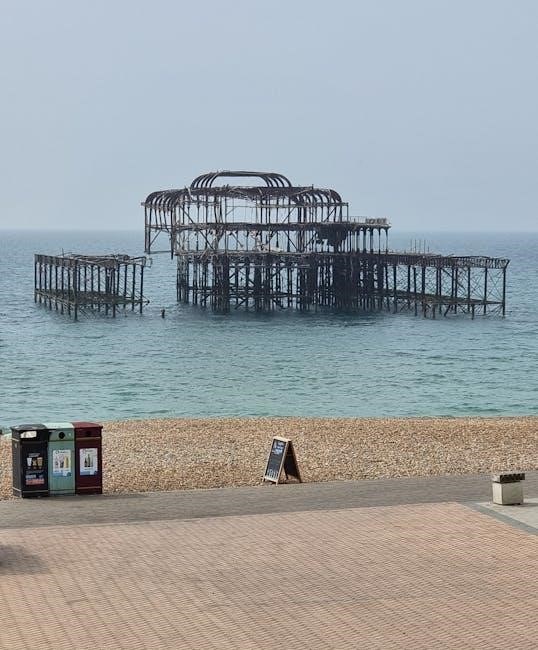brighton beach memoirs pdf

Brighton Beach Memoirs: An Overview
Neil Simon’s “Brighton Beach Memoirs” is a semi-autobiographical play. It centers on Eugene Jerome, a teenager, in 1937 Brooklyn. The play explores his coming-of-age amidst family struggles during the Great Depression. It blends humor with poignant reflections.
Neil Simon and Autobiographical Elements
Neil Simon integrates his own experiences into “Brighton Beach Memoirs.” The play mirrors Simon’s childhood in 1930s Brooklyn, offering a personal glimpse. Eugene’s perspective closely reflects Simon’s. The play presents an autobiographical portrait.
Simon’s Life and Inspiration
Neil Simon’s early life significantly shaped his writing, providing rich material for his plays. Growing up in a lower middle-class Brooklyn apartment during the Great Depression, Simon experienced firsthand the challenges and dynamics of a close-knit family. These experiences, combined with his passion for baseball and observations of adolescent life, served as key inspiration for “Brighton Beach Memoirs;”
Simon’s ability to blend humor with the darker realities of poverty and illness stemmed from his own life. The play reflects his memories and captures the essence of his youth, making it a deeply personal and relatable work. Simon’s family memoir is darkly funny.
The Eugene Trilogy
“Brighton Beach Memoirs” is the first installment in Neil Simon’s semi-autobiographical Eugene Trilogy. The trilogy follows Eugene Morris Jerome’s journey through adolescence and into adulthood. “Biloxi Blues,” the second play, depicts Eugene’s experiences in the army during World War II, exploring themes of identity and self-discovery. “Broadway Bound,” the final play, chronicles Eugene’s early career as a comedy writer alongside his brother Stanley.
Each play in the trilogy offers a unique perspective on Eugene’s life. It reflects Simon’s own experiences, providing a comprehensive portrait of the artist as a young man. The trilogy captures the essence of Simon’s life.
Plot Summary and Setting
Set in 1937 Brooklyn, “Brighton Beach Memoirs” follows Eugene Jerome’s life. He navigates adolescence amidst his family’s struggles. The play explores themes of family, coming-of-age, and the impact of the Great Depression.
Setting in 1937 Brooklyn
The play “Brighton Beach Memoirs” unfolds in the Brighton Beach section of Brooklyn, New York, during September 1937. This setting is crucial as it’s the late Depression era. The Jerome family lives in a crowded, lower middle-class home. The setting reflects the economic hardships of the time, with the family facing financial difficulties.
Eugene’s perspective is key to understanding the setting, as he observes the world around him with a teenager’s eyes. The play captures the atmosphere of a close-knit, immigrant community. It highlights the challenges and resilience of families during the Great Depression.
Eugene’s Perspective
The story of “Brighton Beach Memoirs” is told through the eyes of Eugene Morris Jerome. He is a 14-year-old teenager preoccupied with baseball and girls. Eugene’s narration offers a humorous and insightful look at his family’s life. His perspective reveals his coming-of-age experiences.
Eugene is living with his parents, brother, aunt, and cousins. He often breaks the fourth wall, directly addressing the audience. This provides commentary on the events unfolding around him. His observations are both funny and poignant, reflecting his youthful innocence and growing awareness of the world’s complexities.

Characters and Relationships
“Brighton Beach Memoirs” features a family living together. The play explores the complex dynamics between them. Eugene’s relationships with his family members are central to the story. These relationships shape his coming-of-age journey.
Eugene Morris Jerome
Eugene Morris Jerome, the play’s protagonist, is a fourteen or fifteen-year-old boy navigating adolescence. He lives with his family in Brighton Beach, Brooklyn, in 1937. Eugene is the narrator, offering his humorous and insightful perspective on the events unfolding around him. He is preoccupied with baseball, particularly the Yankees, and his burgeoning interest in girls, especially his cousin Nora.
Eugene’s character serves as the audience’s guide. He reflects on family dynamics, economic hardships, and the challenges of growing up during the Great Depression. Through his eyes, the audience witnesses the struggles and triumphs of the Jerome family. His narrative voice is both witty and poignant, providing comedic relief amidst the play’s more serious themes.
Stanley Jerome
Stanley Jerome is Eugene’s older brother. He faces different challenges in “Brighton Beach Memoirs.” He is struggling with the responsibilities of adulthood during the Great Depression. Stanley works to support the family. He feels the pressure of providing financial stability. Stanley’s character represents the anxieties and burdens experienced by young adults during that era.
He grapples with difficult decisions and moral dilemmas related to his job and his family’s needs. He serves as a role model for Eugene, albeit one who is also flawed and vulnerable. Their relationship highlights the complexities of brotherhood. The play also explores the impact of economic hardship on family relationships.
Nora and Laurie
Nora and Laurie are Eugene’s cousins. They add another layer to the family dynamics in “Brighton Beach Memoirs.” Nora is portrayed as beautiful and talented. Eugene is infatuated with her. She dreams of becoming a dancer. Laurie, on the other hand, is presented as frail and sickly. Her mother is overly protective of her.
The cousins represent different aspects of adolescence and womanhood during the 1930s. Their presence in the household contributes to the play’s exploration of family tensions, dreams, and the challenges faced by young women in that era. Eugene is lusting after Nora and this creates a problem.

Themes Explored in the Play
“Brighton Beach Memoirs” delves into themes of coming-of-age. It also considers family dynamics, and the impact of the Great Depression. These are all seen through Eugene’s eyes. They offer a poignant, humorous look at life.
Coming-of-Age
The play portrays Eugene’s journey through adolescence. It explores themes of puberty, and sexual awakening, within a family context. Eugene grapples with his changing body, and desires for his cousin Nora. His infatuation provides comedic relief. It also highlights his innocence. He dreams of baseball and girls. This encapsulates the typical teenage preoccupations of the time.
Eugene’s perspective shapes the narrative. It allows the audience to witness his evolving understanding of the world. He learns about responsibility, and family obligations, all while navigating his personal desires. Simon masterfully blends humor and pathos. This captures the awkwardness, and wonder, of adolescence in 1930s Brooklyn.
Family Dynamics
The Jerome household is a microcosm of familial relationships. It reveals the stresses, and supports, within a multi-generational home. The play examines the bonds between Eugene, his parents, brother, aunt, and cousins. Each character contributes to the complex web of interactions. Financial pressures from the Great Depression strain their relationships. They lead to conflicts, and sacrifices.
The dynamics between siblings, and cousins, are explored. Eugene looks up to his older brother, Stanley. He admires his strength, and independence. The relationship between Nora and Laurie is complex. It involves jealousy, and support. Despite challenges, the family unit provides a sense of belonging. They demonstrate resilience, and love, amidst adversity.
The Great Depression’s Impact
Set in 1937, “Brighton Beach Memoirs” vividly portrays the impact of the Great Depression on an average family. The Jerome family grapples with financial instability. They face the constant threat of poverty. The economic hardship forces them to share a cramped house with relatives. This adds tension, and friction, to their daily lives.
The characters’ anxieties are heightened by the scarcity of resources. They highlight the era’s pervasive uncertainty. Stanley’s struggles at work underscore the difficulty of finding, and keeping, a job. The family’s resourcefulness, and determination to survive, are also highlighted. They demonstrate the resilience of individuals during times of widespread economic hardship. The play serves as a reminder of the era’s lasting impact on American families.

Adaptations and Awards
“Brighton Beach Memoirs” was adapted into a film in 1986. It also received Tony Award nominations. These accolades recognize the play’s impact. They also acknowledge its enduring appeal to audiences.
1986 Film Adaptation
The 1986 film adaptation of “Brighton Beach Memoirs” brought Neil Simon’s autobiographical story to a wider audience. Directed by Gene Saks, the movie captured the essence of the play’s setting in 1930s Brooklyn. It allowed viewers to witness Eugene’s coming-of-age journey.
The film featured talented actors who embodied the beloved characters. It visually depicted the Jerome family’s struggles and humorous moments during the Great Depression. The adaptation aimed to preserve the play’s themes of family dynamics, adolescence, and the pursuit of dreams amidst hardship.
While staying true to the source material, the film offered its own interpretation of the story. This provided a different perspective on Eugene’s experiences. The movie remains a popular adaptation. It provides a glimpse into Simon’s childhood memories and the challenges faced by families during that era.
Tony Award Nominations
“Brighton Beach Memoirs” received recognition for its theatrical merit. The play earned several Tony Award nominations. This acknowledged the outstanding performances, direction, and overall production quality. The nominations highlighted the play’s impact on the Broadway stage and its ability to resonate with audiences.
While the play may not have won all the awards it was nominated for, the nominations themselves signified a high level of achievement. The recognition from the Tony Awards solidified “Brighton Beach Memoirs” as a significant work in American theater.
The nominations brought attention to Neil Simon’s writing and the play’s themes of family, coming-of-age, and the challenges of the Great Depression. The Tony Award nominations served as a testament to the play’s artistic merit and its lasting legacy in the world of theater, despite not securing a win in every category.

Availability of “Brighton Beach Memoirs” in PDF Format
Many websites offer “Brighton Beach Memoirs” in PDF format. Some sites provide free downloads, while others require purchase or rental. These digital versions allow easy access to the play’s script.
Free PDF Downloads
Finding a free PDF download of “Brighton Beach Memoirs” can be a convenient way to access the play’s script. Several online platforms may offer the play as a free PDF, often as part of a collection of theatrical works or study materials. However, users should exercise caution when downloading from unknown sources to avoid potential copyright infringements or malware risks. Always ensure the source is reputable and that downloading the PDF aligns with copyright regulations. Check educational websites, online libraries, or fan forums dedicated to Neil Simon’s work, as they might provide legitimate access to the play’s script without cost.
Where to Buy or Rent Online
For those seeking to purchase or rent “Brighton Beach Memoirs” online, numerous options are available. Digital platforms like Amazon, Apple TV, and Fandango At Home offer the play for download or rental, providing convenient access for viewers. Additionally, streaming services may occasionally include the film adaptation in their library, offering another avenue for viewing. When considering purchasing or renting, compare prices and availability across different platforms to find the most suitable option. Remember to check for any regional restrictions or subscription requirements that may apply. Some online retailers might also offer physical copies of the play’s script or the DVD of the film adaptation.
Leave a Reply
You must be logged in to post a comment.